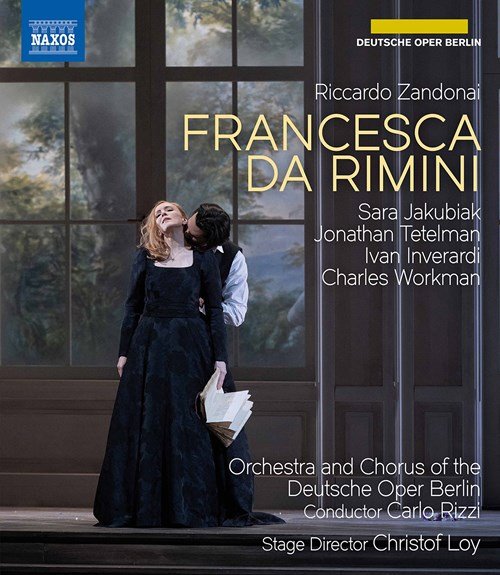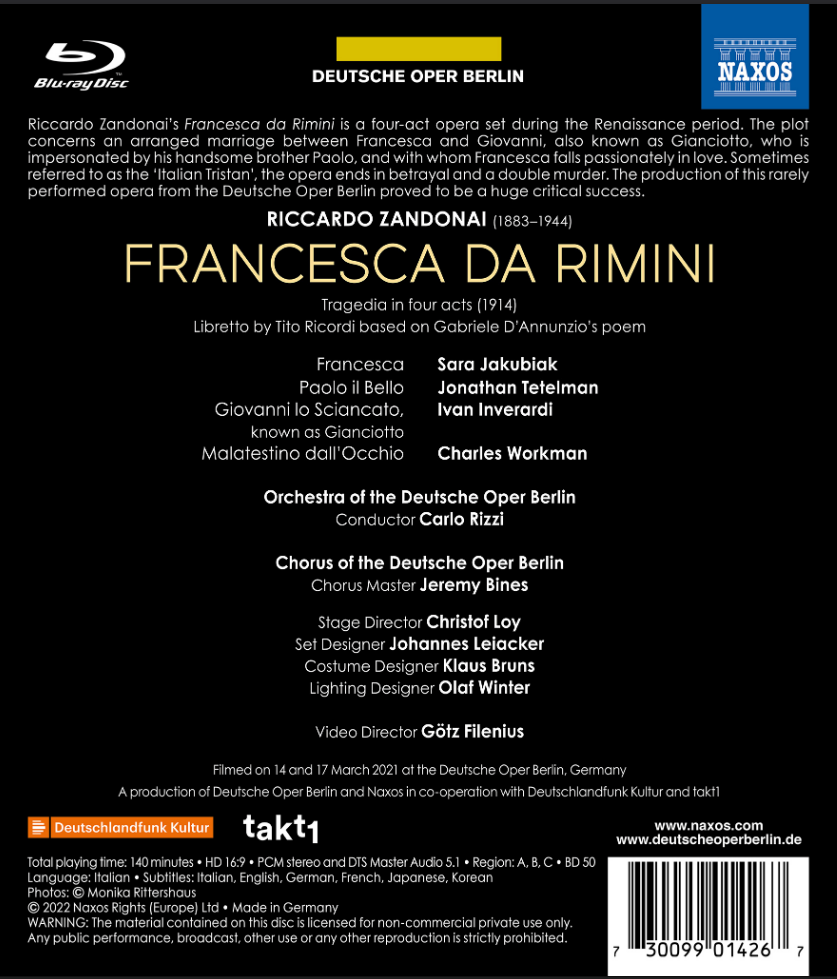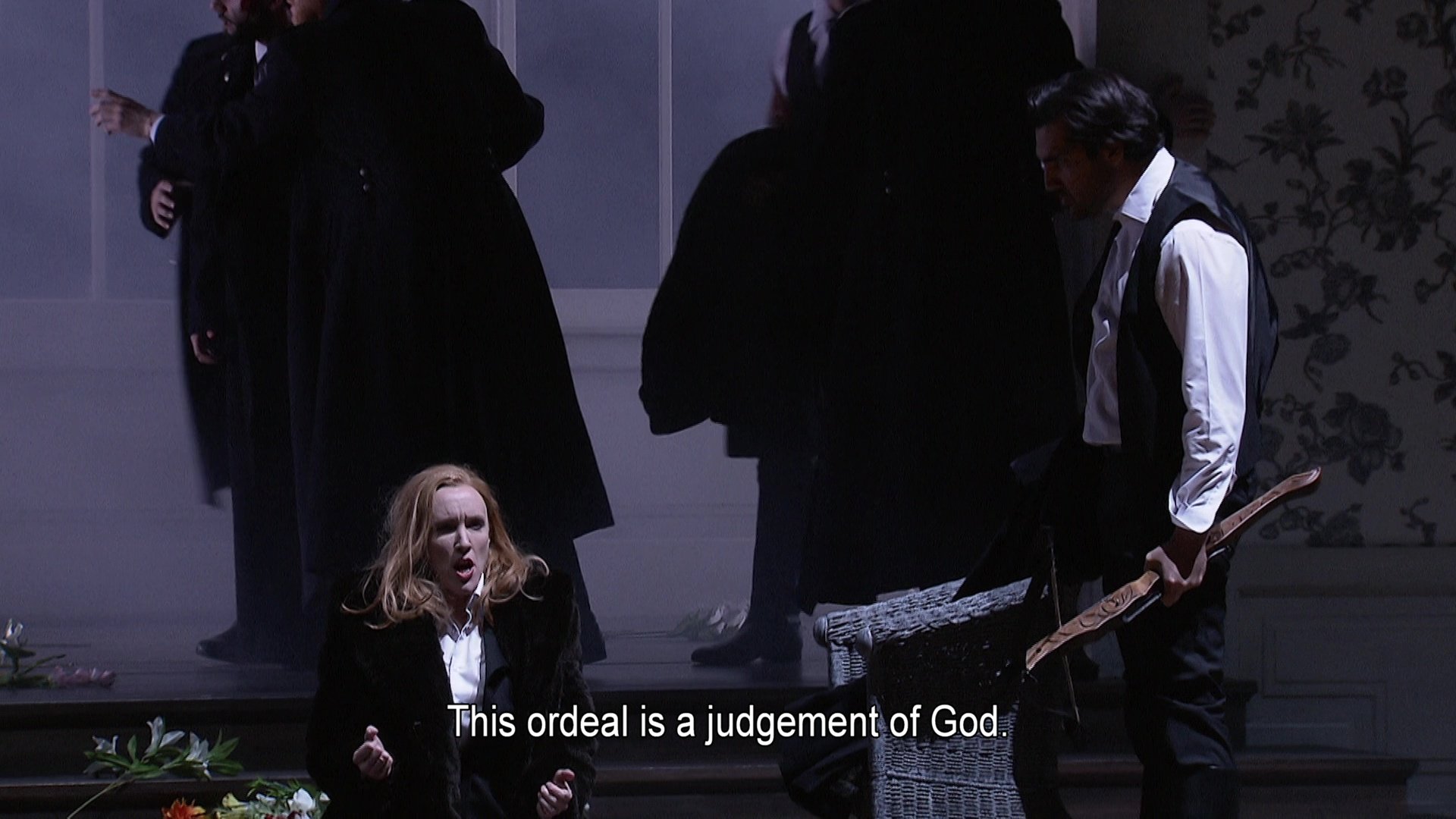

Riccardo Zandonai Francesca da Rimini opera to libretto by Tito Ricordi. Directed 2021 by Christof Loy at the Deutsche Oper Berlin. Stars Sara Jakubiak (Francesca), Jonathan Tetelman (Paolo il Bello), Ivan Inverardi (Giovanni lo Sciancato, or The Lame), Charles Workman (Malatestino dall’Occhio or The One-Eye), Alexandra Hutton (Samaritana), Samuel Dale Johnson (Ostasio), Meechot Marrero (Biancofiore), Mané Galoyan (Garsenda), Arianna Manganello (Altichiara), Karis Tucker (Adonella), Amira Elmadfa (Smaragdi), Andrew Dickinson (Ser Toldo Berardengo), Dean Murphy (Il giullare or The Jester), Patrick Cook (Il balestriere or The Crossbowman) / Prisoner’s Voice), Thomas Lehman (Il torrigiano or The Towerkeeper). Actors are Jan Gerrit Brüggemann, Farouk El-Khalili, Hanno Jusek, Marcus Mundes, Andrea Spartá, Koray Tuna, Benjamin Werth, Nicolas Franciscus, Franz Gnauck, Kay Bretschneider, Paul Krügener, Lukas Lehner, Maximilian Reisenger, and Pablo Nina Toculescu. Carlo Rizzi conducts the Orchestra of the Deutsche Oper Berlin, the Chorus of the Deutsche Oper Berlin (Chorus Master Jeremy Bines), and Supernumiaries of the Deutsche Oper Berlin. Set design by Johannes Leiacker; costume design by Klaus Bruns; lighting design by Olaf Winter. Directed for TV by Götz Filenius. Sung in Italian. Released 2022, disc has 5.1 dts-HD Master Audio sound. Grade: A
In the 13th century the land now called Italy was divided into warring oligarchic city-states. In 1275 Francesca Polentani of Ravenna was married to Giovanni Malatesta of Rimini, known as Giovanni the Lame, to bolster the strength of both families. The bride became Francesca of Rimini. While still married to Giovanni, Francesca fell in love with Giovanni’s brother, Paolo the Handsome. Eventually, the Lame caught the Handsome in bed with Francesca and killed them both. Dante knew of this. In his Inferno, Dante puts Francesca and Paolo in the second circle of hell.
Ever since, Francesca and Paolo have been the subject of plastic artists and writers. For example, below left is a painting from 1863 by Gustave Doré called The Souls of Paolo and Francesca. Below right is the famous Rodin statute known as The Kiss. It was originally intended to be Francesca and Paolo:
There were about 45 theater, opera, and film works published during the 19th and 20th centuries about the tragic couple. Our Riccardo Zandonai verismo opera from 1914 is the most prominent of these.
This grim story of doomed lovers gives no opportunity for comic relief. To soften the drama, Zandonai gives some beautiful incidental music sung by young ladies in waiting to Francesca. And director Loy gives a prominent role to a mostly mute Jester/Musician (Dean Murphy ) seen below telling about the story of Tristan and Isolde. The Jester represents the common people whose lives are so often impacted by the fighting going on among the aristocrats. And the Jester’s announcement also suggests that Zandanai hoped to compose the story of Francesca and Paolo as a verismo reincarnation of Wagner’s Tristan and Isolde. Standing on the right in black tie is Francesca’s slave Smaragdi (Amira Elmadfa ). Smaragdi mostly observes in silence, but she is Francesca’s most trusted confidant:
We are in Ravenna in the palace of the Polentani family. Below, Francesca’s brother Ostasio (Samuel Dale Johnson ) is with the Polentani family notary, Ser Toldo Berardengo (Andrew Dickinson). Ostasio desperately needs to marry his beautiful sister Francesca to Giovani the Lame, the deformed and older leading knight of the Malatesta clan in Rimini. Ostasio fears Francesca would not agree to this. So he and the notary have hatched up a plan to trick Francesca into signing the marriage contract. The paper will be presented to her by Giovanni’s younger brother, Paolo the Handsome. By the time Francesca learns that she has agreed to marry Giovanni the Lame, it will be too late for her to back out:
Before the signing of the marriage contract takes place, we meet Francesca (Sara Jakubiak ) and her sickly younger sister Samaritana (Alexandra Hutton ). Samaritana begs Francesca not to wed. And Francesca seems content also to live out her life in her father’s house as a virginal spinster rather than become Queen in another place:
Francesca hears that Malatesta men are arriving, and she retires to her quarters. All the women at court are atwitter and assume Poalo the Handsome (Jonathan Tetelman) is the groom. Poor Samaritana faints—she knows she is loosing forever the protection of her strong older sister:
What could possible go wrong? Well, for starters, it’s love at first sight for both the bride and the messenger. Against all protocol and contrary to plan they kiss on the lips:
In a daze, Francesca signs the contract. But when she finally looks up again to gaze again the man she kissed, she sees the older man who will be her husband. This is the end of Act 1:
Next, seconds later, we are in Rimini in the Malatesta palace some time after the wedding. The set hasn’t changed at all. But Francesca is wearing a more regal gown than before. She is now the Rimini Queen. It appears Loy didn’t have the funds needed for a scene change. When I first watched this cold, I got quite confused. So here’s a tip: when you see Francesca below with the broad shoulders, know that you are in Act 2. The big battle between the Malatestas and their enemies has just broken out! And Francesca is going to be in the thick of it!
As is Paolo. Both Francesca and Paolo view this battle as a trial before God. If the Malatesta clan prevails, God will forgive Ostasio and Paolo for tricking Francesca into marrying The Lame. Francesca is still in love with Paolo, but she will accept her fate for the greater good:
But Paolo reveals during the battle that he is still in love with his sister-in-law!
During a lull in the battle, Francesca shares wine with her husband and with Paolo (another echo of Tristan und Isolde):
And yet another brother, Malatestino (Charles Workman) is brought in from the battlefield with an injured eye. He will thereafter become known as the One-Eyed. He gets a drink of the wine also. From this time on, all three Malatesta brothers are in love with the same woman. This is the reward they get for engineering the union of the union of the Polentani and Malatesta clans:
Francesca exults in the victory of the clans:
But Francesca’s problems are only increasing. Now One-eye also presses Francesca for satisfaction!
The tension of being loved by 3 warrior brothers is beginning to destroy Francesca:
Only the slave Smaragdi grasps Francesca’s dilemma. Below is my favorite dialog from the libretto:
Smaragdi knows that only Paolo’s love can save her mistress. But Francesca still fights to do the right and honorable thing:
Every dam breaks. Francesca and Paola read together from a book about the forbidden love of Tristan and Isolde:
The sadistic One-eye inflames The Lame against Francesca and The Handsome:
Now Paolo is in Francesca’s bedroom. Oblivion is only a few seconds away, but not in the way Paolo has in mind:
A lot of critics wrote this up. Tim Ashley (May 2022 Gramophone, pages 102-104) was ecstatic over what he calls a “great achievement” by Loy as director. He reports that all the leading and supporting stars perform their roles flawlessly as singers and actors. Finally, Ashley credits Carlo Rizzi with forging an “extraordinary unity from an astonishingly beautiful if eclectic score.” David Shengold, writing in the August 2022 Opera News (pages 58-59) validates “Zondonai’s demanding score, evoking not only Wagner but also Debussy and Mahler.”
John from operaramblings.blog (February 19, 2022) liked the singing, acting and “almost impossible to pull off battle scene.” John goes to say that “overblown romanticism and an overwrought fixation on sex and violence are not my thing, but I suspect that the production add performances here are about as good as this piece can get.”
Discouraging words were heard from Jim Pritchard in a long review (seenandheard-international.com of March 16, 2021) proving that Zandonai was not as good a composer as Richard Wagner. After reading that, I dug out my trusty 2007 Tristan und Isolde Blu-ray from Glyndebourne (Gambill/Stemme). After dosing on verismo, I found Wagner too slow and grueling to tolerate. I’ll have to come back to T&I another day.
This opera should be on the list of the best 20th Century operas. I like Loy’s show for superlative personal directing of the singers and some 14 mute actors actors who appear. It doesn’t have any Puccini-style “million-dollar” arias, but I liked the music and the up-date mise-en-scène. I admire Francesca for trying to do the right thing. I don’t blame her for loving Paolo. She got a raw deal. That’s why we are interested in her 800 years later. I start with A+ and slide back to an A due to the confusing transition between Act 1 and Act 2.
Here's a nice official clip from Naxos:
OR





























